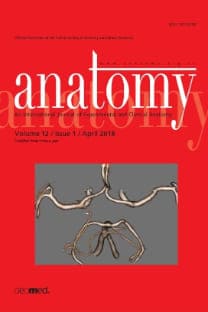The normal width of the linea alba in cadavers – a parameter to define rectus diastasis
abdomen, anatomy, anthropometry, cadaver, rectus abdominis,
___
- Digilio MC, Capolino R, Dallapiccola B. Autosomal dominant transmission of nonsyndromic diastasis recti and weakness of the linea alba. Am J Med Genet A 2008;146:254–6.
- Mendes DA, Nahas FX, Veiga DF, Mendes FV, Figueiras RG, Gomes MC, Ely PB, Novo NF, Ferreira LM. Ultrasonography for measuring rectus abdominis muscles diastasis. Acta Cir Bras 2007;22:182–6.
- Rett MT, Araújo FR, Rocha I, Da Silva RA. Diástase dos músculos reto abdominais no puerpério imediato de primíparas e multíparas após o parto vaginal. Physical Therapy and Research Journal (Revista de Fisioterapia e Pesquisa) 2012;19:236–41.
- Nahas FX, Ferreira LM, Augusto SM, Ghelfond C. Long-term follow-up correction of rectus diastasis. Plast Reconstr Surg 2005;115:1736–41.
- Barbosa MV, Nahas FX, Garcia EB, Ayaviri NA, Juliano Y, Ferreira LM. Use of the anterior rectus sheath for abdominal wall reconstruction: a study in cadavers. Scand J Plast Reconstr Surg Hand Surg 2007;41:273–7.
- Nahas FX. An aesthetic classification of the abdomen based on the myoaponeurotic layer. Plast Reconstr Surg 2001;108:1787–95.
- Barbosa MV, Nahas FX, de Oliveira Filho RS, Ayaviri NA, Novo NF, Ferreira LM. A variation in the component separation technique that preserves linea semilunaris: a study in cadavers and a clinical case. J Plast Reconstr Aesthet Surg 2010;63:524–31.
- Nahas FX, Augusto SM, Ghelfond C. Nylon versus polydioxanone in the correction of rectus diastasis. Plast Reconstr Surg 2001;107:700–6.
- Beer GM, Chuster A, Seifert B, Manestar M, Mihic-Probst D, Weber SA. The normal width of the linea alba in nulliparous women. Clin Anat 2009;22:706–11.
- Gilleard WL, Brown JMM. Structure and function of the abdominal muscles in primigravid subjects during pregnancy and the immediate postbirth period. Phys Ther 1996;76:750–62.
- Nahas FX, Ferreira LM, Mendes JA. An efficient way to correct recurrent rectus diastasis. Aesth Plast Surg 2004;28:189–96.
- Nahas FX, Barbosa MV, Ferreira LM. Factors that may influence failure of the correction of the musculoaponeurotic deformities of the abdomen. Plast Reconstr Surg 2009;124:334.
- Saldanha OR, Azevedo SF, Delboni PS, Saldanha Filho OR, Saldanha CB, Uribe LH. Lipoabdominoplasty: the Saldanha technique. Clin Plast Surg 2010;37:469–81.
- Rodrigues MA, Nahas FX, Reis RP, Ferreira LM. Does diastasis width influence the variation of the intra-abdominal pressure after correction of rectus diastasis? Aesthet Surg J 2015;35:583–8.
- Corvino A, De Rosa D, Sbordone C, Nunziata A, Corvino F, Varelli C, Catalano O. Diastasis of rectus abdominis muscles: patterns of anatomical variation as demonstrated by ultrasound. Pol J Radiol 2019;84:e542–8.
- ISSN: 1307-8798
- Yayın Aralığı: 3
- Başlangıç: 2007
- Yayıncı: Deomed Publishing
Evaluation of knowledge and attitudes of physicians in Turkey about body donation processes
Zeliha Kurto¤lu Olgunus, Çisem Yeflil Kayabaflşı
Menekfle Cengiz, Ayfle Keven, Serra Öztürk, Hande Salim, Murat Gölp›nar, Kemal Gökkufl, Muzaffer Sindel
Kaan YÜCEL, Bahattin HAKYEMEZ, İbrahim BORA
Kaan Yücel, , Bahattin Hakyemez, brahim Bora
Kemal Emre Özen, Kübra Erdo¤an, Gonca Ay Keselik, Mehmet Ali Malas
Hilal Aktaş AKDEMİR, Sinem AKKAFLOĞLU, Mine FAR MAZ, Mustafa Fevzi SARGON
An anatomical study of the bicipital aponeurosis in embalmed and fresh frozen cadavers
Sinem Akkafloğlu, Mine FAR MAZ, Hilal Aktaş AKDEMİR, Mustafa Fevzi Sargon
KEMAL EMRE ÖZEN, Kübra ERDOĞAN, Gonca Ay KESELİK, Mehmet Ali MALAS
Can Whitnall’s tubercle be localized using palpable landmarks around the orbit?
